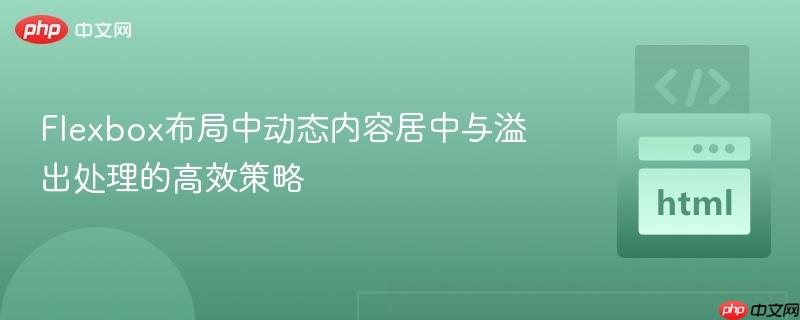
本文探讨了在flexbox布局中,如何优雅地实现内容动态居中,同时有效管理水平方向的溢出,避免首个元素被截断的问题。通过引入一个嵌套的flexbox结构,我们将居中逻辑与溢出处理分离,外层容器负责整体居中,内层容器则负责内容排列与滚动。这种策略确保了无论项目数量多少,布局都能保持美观且功能完整。
在构建响应式Web界面时,Flexbox是实现元素布局的强大工具。然而,当我们需要在一个容器中同时实现内容居中,并且该内容可能超出容器宽度(即发生溢出)时,传统的justify-content: center配合overflow: scroll或overflow: auto可能会导致意想不到的问题。
具体来说,如果一个Flex容器直接应用了justify-content: center来使其子项居中,并且子项的总宽度超出了容器,那么在发生水平滚动时,Flexbox会尝试保持所有子项的“中心”对齐。这通常会导致内容的两端都被截断,尤其是第一个和最后一个子项可能会被部分或完全隐藏,使得用户无法看到完整的内容,也无法通过滚动查看被截断的部分,从而影响用户体验。
为了解决这一冲突,我们可以采用一个巧妙的嵌套Flexbox结构,将“居中”和“溢出滚动”这两个职责分配给不同的容器。
核心思想:
外层容器的主要任务是将其直接子元素(即内层容器)在水平方向上居中。
.center-container {
width: 100%; /* 确保外层容器占据可用宽度 */
background-color: gray; /* 示例背景色 */
display: flex; /* 启用Flexbox布局 */
justify-content: center; /* 将其子元素(内层容器)水平居中 */
margin-bottom: 50px; /* 示例间距 */
}这里,display: flex; 激活了Flexbox,而 justify-content: center; 则确保了其唯一的子元素(内层容器)将在外层容器中水平居中。
内层容器是关键所在,它承载了所有实际的Flex项目,并负责处理溢出。
.overflow-container {
width: fit-content; /* 让内层容器宽度适应其内容的宽度 */
max-width: 100%; /* 防止内层容器宽度超出父容器(.center-container)的可用宽度 */
overflow: auto; /* 当内容溢出时显示滚动条 */
display: flex; /* 启用Flexbox布局,排列内部项目 */
gap: 1em; /* 示例项目间距 */
}Flex项目本身保持常规设置,但需要确保它们不会因容器空间不足而收缩。
.items {
width: 100px; /* 示例固定宽度 */
height: 100px; /* 示例固定高度 */
display: inline-block; /* 保持块级特性,但Flex项可以忽略此设置 */
flex-grow: 0; /* 不允许项目放大 */
flex-shrink: 0; /* 不允许项目缩小,确保固定宽度 */
background-color: blue; /* 示例背景色 */
color: white; /* 示例文字颜色 */
text-align: center; /* 示例文字居中 */
}flex-shrink: 0; 是确保项目在空间不足时不会缩小的关键。
结合上述CSS规则和HTML结构,我们可以构建一个既能居中又能处理溢出的Flexbox布局。
HTML结构:
<div class="center-container">
<div class="overflow-container">
<div class="items">Just one item</div>
</div>
</div>
<div class="center-container">
<div class="overflow-container">
<div class="items">Item 1</div>
<div class="items">Item 2</div>
<div class="items">Item 3</div>
<div class="items">Item 4</div>
<div class="items">Item 5</div>
<div class="items">Item 6</div>
<div class="items">Item 7</div>
<div class="items">Item 8</div>
<div class="items">Item 9</div>
<div class="items">Item 10</div>
<div class="items">Item 11</div>
</div>
</div>
<div class="center-container">
<div class="overflow-container">
<div class="items">Item 1</div>
<div class="items">Item 2</div>
<div class="items">Item 3</div>
<div class="items">Item 4</div>
<div class="items">Item 5</div>
<div class="items">Item 6</div>
<div class="items">Item 7</div>
<div class="items">Item 8</div>
</div>
</div>CSS样式:
.center-container {
width: 100%;
background-color: gray;
display: flex;
justify-content: center;
margin-bottom: 50px;
}
.overflow-container {
width: fit-content;
max-width: 100%;
overflow: auto;
display: flex;
gap: 1em;
}
.items {
width: 100px;
height: 100px;
display: inline-block;
flex-grow: 0;
flex-shrink: 0;
background-color: blue;
color: white;
text-align: center;
}通过这个结构,当overflow-container中的项目数量较少时,width: fit-content会使其宽度恰好包裹内容,然后整个overflow-container会被外层的center-container居中。当项目数量增多导致内容溢出时,overflow-container的宽度会达到max-width: 100%,并激活overflow: auto,使得内容可以从左侧开始滚动,而不会被截断。
通过上述嵌套Flexbox策略,开发者可以灵活地创建既美观又功能完善的响应式布局,有效解决Flexbox中内容动态居中与水平溢出截断的常见问题,提升用户体验。
以上就是Flexbox布局中动态内容居中与溢出处理的高效策略的详细内容,更多请关注php中文网其它相关文章!

每个人都需要一台速度更快、更稳定的 PC。随着时间的推移,垃圾文件、旧注册表数据和不必要的后台进程会占用资源并降低性能。幸运的是,许多工具可以让 Windows 保持平稳运行。

Copyright 2014-2025 https://www.php.cn/ All Rights Reserved | php.cn | 湘ICP备2023035733号